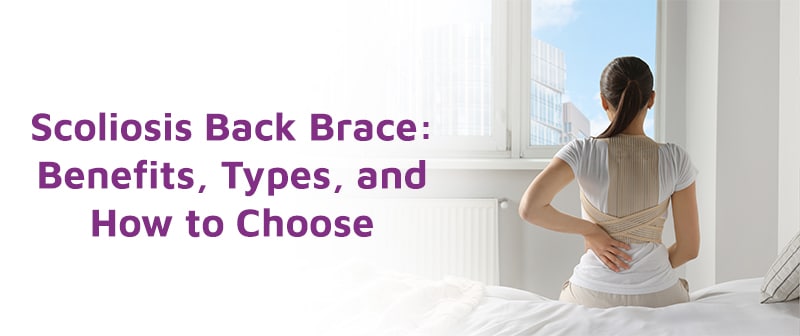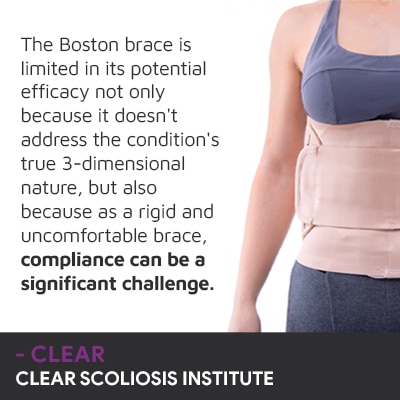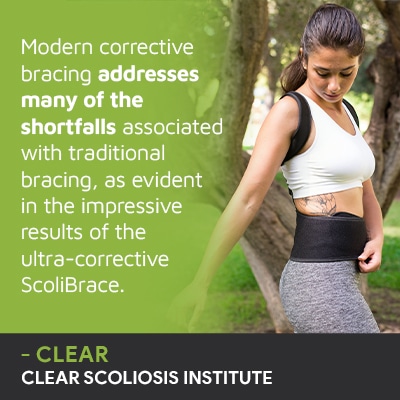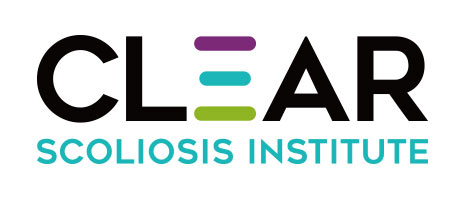
While no back brace on its own is capable of correcting a scoliosis, when combined with other types of treatment, it can augment corrective treatment results. The traditional boston brace is associated with a number of shortfalls that are addressed by modern corrective bracing, so understanding how the different treatment approaches shape spinal health is important.
Choosing the best back brace for scoliosis means fully understanding the different scoliosis treatment approaches. Traditional scoliosis bracing has the goal of stopping scoliosis from getting worse, while modern corrective bracing has the goal of correcting scoliosis.
Let's start by exploring the two main scoliosis treatment approaches because once a patient is on the path of traditional or conservative treatment, the brace that's aligned with the approach is recommended.
Receiving a scoliosis diagnosis can be a lot to process; not only does it mean a person has developed an unnatural sideways-bending and twisting spinal curve, it also means being diagnosed with a progressive and incurable condition.
As a progressive condition, the nature of scoliosis is to get more severe over time, and this means the size of the unhealthy spinal curvature is going to increase, as are the condition's effects.
Scoliosis treatment is more about how best to manage an ongoing condition than it is about fixing scoliosis permanently.
That being said, vast improvements can often be made to the health and function of a patient's scoliotic spine, but the chosen treatment approach is key because how a diagnosis is responded to with treatment will determine the spine's long-term health.
There are also different types of scoliosis, and scoliosis affects all ages; however, scoliosis is most often diagnosed in children and adolescents, and as bracing is most effective on growing spines, it is a common facet of treatment for childhood scoliosis.
The two treatment approaches patients have to choose between are known as traditional and conservative, and the former offers a surgical response, while the latter provides a less-invasive nonsurgical treatment alternative.
Let's start with the potential outcome offered by traditional scoliosis treatment and traditional bracing.
Scoliosis has been around since ancient times, and the traditional treatment approach was the dominant choice for many years, but over time, another treatment option has emerged, a conservative nonsurgical approach.
Traditional scoliosis treatment favors a wait-and-see recommendation for cases that are mild, but when conditions are mild is the best time to start treatment; curves are smaller and more simple to treat, and the spine is more flexible and responsive to treatment.
In addition, while we don't fully understand why most cases of scoliosis develop, we do know what makes them progress: growth.
In young patients who are going through puberty, rapid-phase progression is a risk, so merely observing for progression, rather than actively working towards preventing it, can also be risky.
Traditional scoliosis treatment does little to prevent progression, other than the prescription of traditional bracing for moderate scoliosis patients, but traditional bracing is associated with a number of cons.
There are different types of braces used in scoliosis treatment such as nighttime braces, the Charleston bending brace, the milwaukee brace, Wilmington brace, the Providence brace, and the Rigo cheneau brace; the most commonly-prescribed brace in traditional treatment is the boston brace.

A patient's Cobb angle is determined during a scoliosis X-ray and tells me how severe conditions are; the higher a patient's Cobb angle, the more unnaturally tilted and twisted the spine is.
The boston brace is a thoracic lumbar sacral orthosis that is worn around the torso with the goal of stopping scoliosis from progressing: the main treatment goal of traditional scoliosis treatment.
So the goal of traditional bracing reflects the goal of the treatment approach as a whole, and this is to observe conditions while mild because traditional treatment doesn't have a strategy for treating them while mild, and commonly, bracing is applied for moderate scoliosis patients.
The boston brace is associated with a number of cons:
The boston brace works via a 3-point pressure system that squeezes the spine at particular locations within the curve, but a scoliotic spine is already weaker, and being squeezed excessively during full-time brace wear can make the spine increasingly weak and vulnerable to injury.
The boston brace is limited in its potential efficacy not only because it doesn't address the condition's true 3-dimensional nature, but also because as a rigid and uncomfortable brace, compliance can be a significant challenge.
Full time braces can mean being worn anywhere from up to 23 hours a day for up to five years, but to be effective, all braces have to be worn exactly as prescribed.
If bracing isn't successful at stopping progression and patients continue to progress and become severe, spinal fusion surgery is commonly recommended, and this is a costly, invasive, and risky procedure that can cost the spine in terms of its overall long-term health and flexibility.
A conservative scoliosis treatment approach has a different treatment goal: to achieve corrective results and avoid surgery, so let's talk about conservative treatment and the brace it's aligned with.
Conservative nonsurgical scoliosis treatment wants to correct scoliosis, and this means addressing its underlying structural nature in the form of a curvature reduction, and as conservative treatment is proactive and prioritizes preventing progression, treatment is started immediately following a diagnosis; there is no watching and waiting.
A conservative approach wants to start treatment while conditions are at their mildest because this is when they are the simplest to treat and are likely to be the most responsive.
The spine gets increasingly rigid as scoliosis gets more severe, and this can make it less responsive to chiropractic care, adjustments, and can make it challenging for some patients to perform therapeutic exercises as part of treatment.
Conservative treatment responds immediately to a diagnosis, and it's an integrative approach that combines the power of multiple scoliosis-specific treatment disciplines such as condition-specific chiropractic care, physical therapy, scoliosis-specific exercises, a variety of therapies, corrective bracing, and rehabilitation.
Just as there is a significant difference between wanting to stop scoliosis from getting worse and wanting to correct it, the braces favored by each approach also differ in their designs and end goals.
Modern corrective bracing addresses many of the shortfalls associated with traditional bracing, as evident in the impressive results of the ultra-corrective ScoliBrace.
The ScoliBrace has a different end goal than stopping progression; as part of a conservative treatment approach, its goal is to augment corrective treatment results.
The ScoliBrace is modern, innovative, and is made from flexible material that's more comfortable and easier to conceal under clothes than traditional bracing.

A brace that's more comfortable to wear is going to address the main challenge to bracing as a facet of scoliosis treatment: compliance.
The ScoliBrace addresses scoliosis as a 3-dimensional condition and works by pushing the spine, instead of squeezing it, so it isn't known to weaken an already-vulnerable spine.
When it comes time to treat scoliosis, choosing a treatment approach that's aligned with a patient's desired potential outcome is important, and patients need to put time and thought into which approach will be better for their long-term spinal health, as spinal health can affect quality of life throughout treatment and beyond.
And remember, as a progressive condition, there is no curing scoliosis, hence the importance of treatment.
So the ScoliBrace has these benefits over traditional bracing:
The goal of the ScoliBrace is to help correct scoliosis as one facet of treatment, but in traditional treatment, bracing isn't combined with a number of other treatment disciplines, so patients are funneled towards surgical intervention.
Choosing the right scoliosis back brace means being informed about the different options available, and the different bracing options are driven by the treatment approach they're a part of.
So choosing the right scoliosis brace also means choosing the best treatment approach.
While traditional treatment and spinal fusion surgery can straighten an unnaturally-bent spine, what it can also do is make the spine weaker and more vulnerable to injury, less flexible, and more painful.
Once a spine is fused, it's fused for life, and if the procedure is deemed unsuccessful, the only recourse is more surgery, which means increasing risks.
The boston brace is the most commonly-prescribed traditional scoliosis brace, but the approach it's tied to already limits its potential efficacy, as does the fact that it doesn't address the condition's true 3-dimensional nature.
The ScoliBrace is commonly used in conservative nonsurgical treatment for its corrective potential, and as part of a conservative treatment approach, the goal of bracing is to help correct scoliosis while preserving as much of the spine's natural strength, flexibility, and function as possible.
Conservative treatment applies chiropractic care and adjustments to work towards reducing the size of the unnatural spinal curve, while simultaneously working towards increasing core strength so the spine receives more support from its surrounding muscles, along with improving posture, and corrective bracing can help achieve these things by pushing the spine into a corrective position: complementing the other types of treatment applied.
Here at the CLEAR Scoliosis Institute, the priority is to treat the entire spine, the whole patient, and make improvements to long-term spinal health through proactive treatment that prioritizes long-term spinal health.

CLEAR provides a unique and innovative way of understanding scoliosis. Sign up to receive facts and information you won’t find anywhere else.
